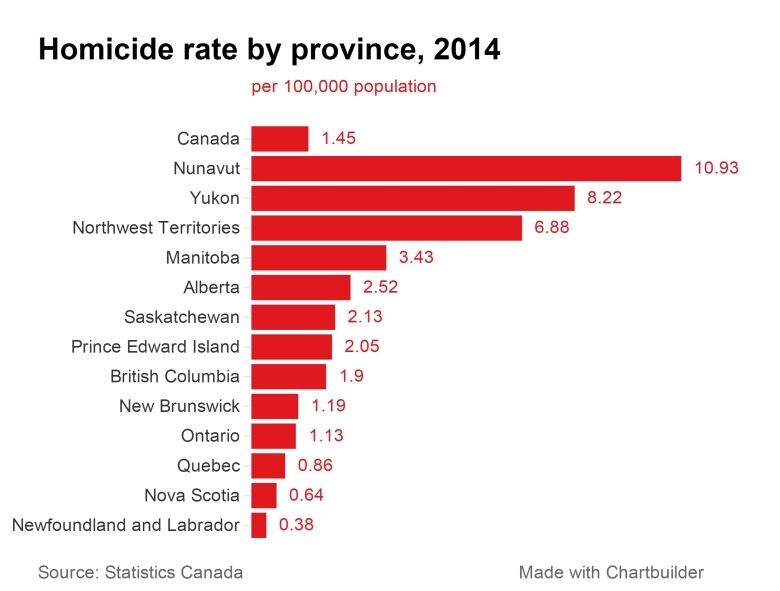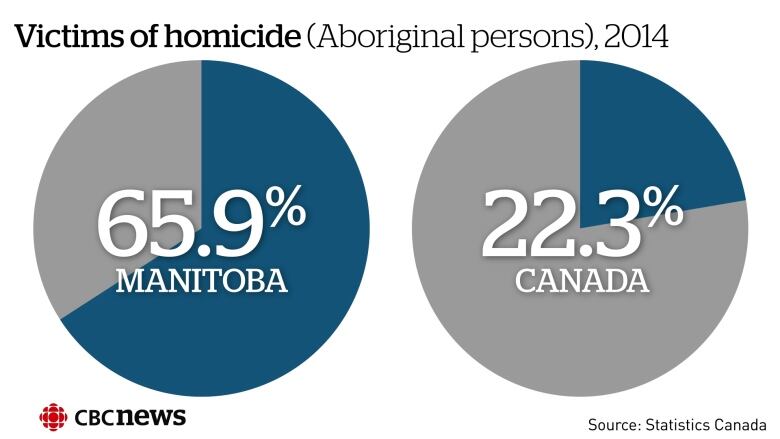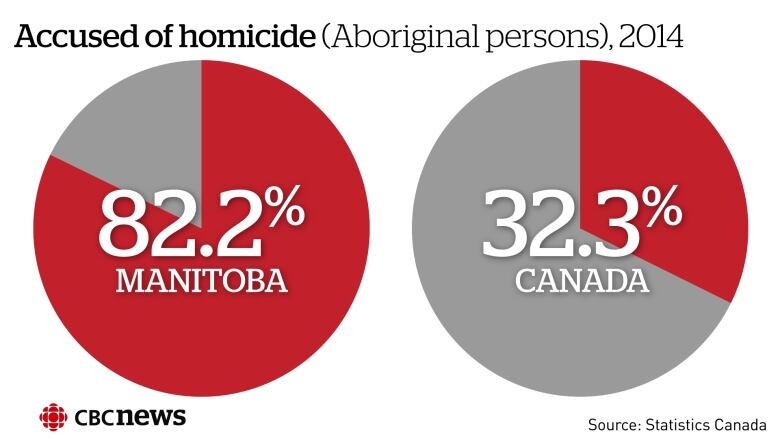Manitoba posts highest homicide rate in Canada for 8th consecutive year
23% of homicide victims in Canada in 2014 were aboriginal, according to Statistics Canada
Manitoba has the highest homicide rate among the provincesfor the eighth consecutive year, according to a new report from Statistics Canada.
With a homicide rate of 3.43 per 100,000 residents in 2014, Manitoba surpasses:
- Alberta, which was second with a homicide rate of2.52.
- Saskatchewan, in the third spot, at2.13.
Police forces in Manitoba reported 44 homicides last year, down from 51 in 2013. For Winnipeg and its surrounding bedroom communities (census metropolitan area), 26 homicides were reported, down one from 2013.

Almost a quarter 23 per cent of all homicide victimsin the country wereaboriginal, a group thataccounted for just five per centof the population.
Aboriginal men were seven times more likely to be victims of homicide and aboriginal women were six times more likely compared with the non-aboriginal population, the report indicates.
"I think this issue does still need to be addressed in a gender-specific way," saidDawn Lavell-Harvard, president of the Native Women's Association of Canada.
"Do they need to call a separate inquiry for aboriginal men or aboriginal people in general? Or do we somehow need to call attention to this? Absolutely."
- New homicide statistics no surprise to indigenous women's advocate
- RCMPconfirm report of more than 1,000 murdered aboriginal women
The homicide rate for aboriginal people in Manitoba is the highest in the country, with 13.3 homicides per 100,000 residents, Statistics Canada reported. The homicide rate last year for aboriginal people in the province was nine times higher than for the non-aboriginal population.
Nationally, thehomicide rate for aboriginal peoplewas 7.2 victims per 100,000 residents.
For the first time, police-reported data includes whether victims and people accused of homicide wereaboriginal.
Of the 431 people accused of homicide in Canada, 32 per cent wereaboriginal10 times higher than the rate for non-aboriginal people.
Statistics Canada said it worked withRCMP and other police forces to compile the data.
"In response to increasing efforts in Canada to address societal concerns regarding the prevalence of missing and murdered aboriginal girls and women, the policing community has amended their policies which prevented the reporting of aboriginal identity of victims and persons accused of homicide to the homicide survey," Statistics Canada said in a statement.
1st-time figures on slain aboriginal men
In 2014, the RCMP released a Canada-wide report on the number of missing and murdered aboriginal women, indicating that 1,181 aboriginal women were victims of homicide between 1980 and 2012.
The Statistics Canadarelease Wednesday shows aboriginal men were three times more likely to be victims of homicide than aboriginal women.
"The reality is the homicide rate for aboriginal men is much higher and has always been much higher," said Neil Boyd, director of the school of criminology at Simon Fraser University.
"There's a disturbing, unfortunate legacy, and it's something that we all collectively need to put a good deal of effort into trying to resolve."
It also concludes that the number of aboriginal female homicide victims has remained stable. However, due the decreasing number of non-aboriginal women homicide victims, indigenouswomenincreasingly represent a larger proportion of total female homicide victims. In 1991, aboriginal women accounted for 14 per cent of all all female homicidevictims.In 2014, that climbed to 21 per cent.


Disproportionately accused
Across Canada, in nearly one-third of all homicide cases in 2014, the accused person was of aboriginal descent, although indigenous peopleonly make upfive per cent of the Canadian population, the report shows. The likelihood aboriginal people will beaccused of homicide is 10 times greater than for the non-aboriginal population.
| How do police determine if a victim or accused is aboriginal or non-aboriginal? Aboriginal identity is determined by police through information found with the victim or accused person, such as status cards, or through information supplied by victims' or accused persons' families, the accused persons themselves, community members, or other sourcessuch as band records. Forensic evidence such as genetic testing results may also be an acceptable means of determining the aboriginal identity of victims. Identity reported as "unknown"by police includes instances where police are unable to determine the aboriginal identity of the victim or accused person, where aboriginal identity is not collected by the police service, or where the accused person has refused to disclose their aboriginal identity to police. Source: Statistics Canada |
A 'natural outcome of systemic oppression
The grim statistics are no surprise to the head of Ka Ni Kanichihk, a non-profit organization that provides programs and services to Winnipeg's aboriginal community.
Executive director Leslie Spillett saidthe numbers quantify what her group has known for years.
"That is a natural outcome of systemic oppression. So people internalize a lot of the pain that's been inter-generationally passed down and continues to [be] perpetrated."
Spillett saidgrinding poverty many First Nations people experience is also part of the explanation.
"I can't imagine sometimes how people manage.It's vicious. It's violent, but it's created by relationships and systems."
Winnipeg policeDeputy Chief Danny Smyth said there is still much work to be done to address issues involving crime affecting First Nations.
"Social circumstances that many people find themselves in and a lot of indigenous people find themselves in, poverty, homelessness, you know, losing that cultural identity, these are all things that have contributed."
Smyth said the police service is working with social organizations, such as Block to Block in the city's North End, to address some of the root causes.
"We're a partner in that, along with a lot of other social agencies, to really try to help families that are vulnerable."













_(720p).jpg)


 OFFICIAL HD MUSIC VIDEO.jpg)
.jpg)



























































































